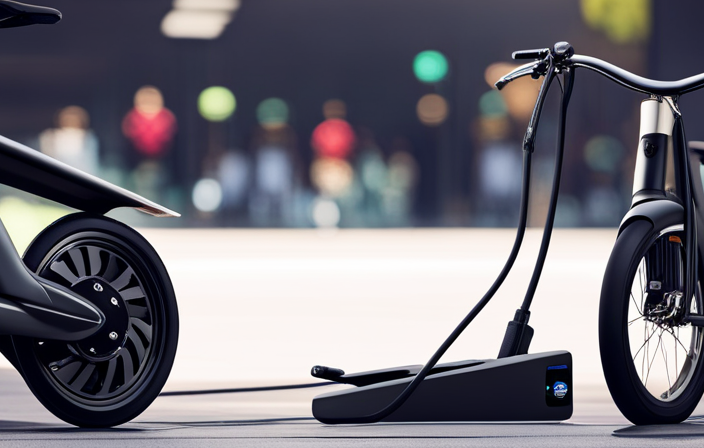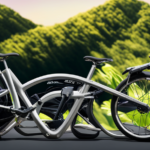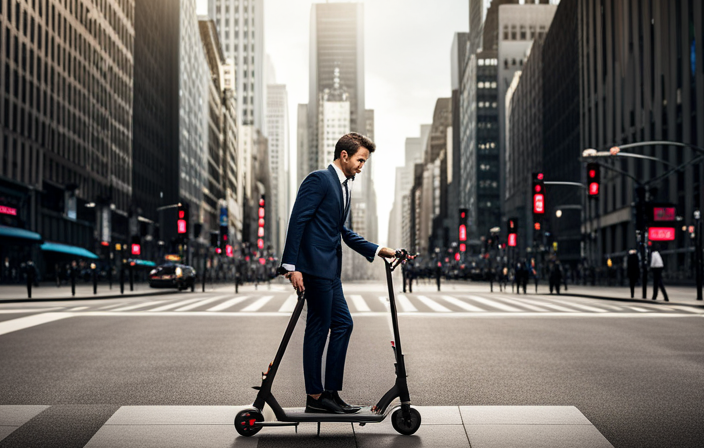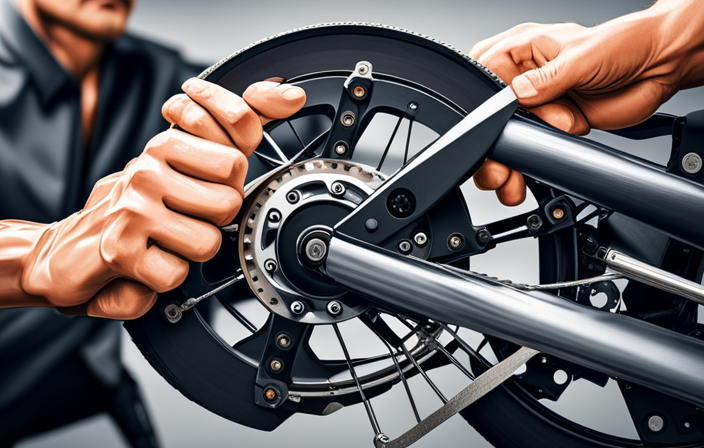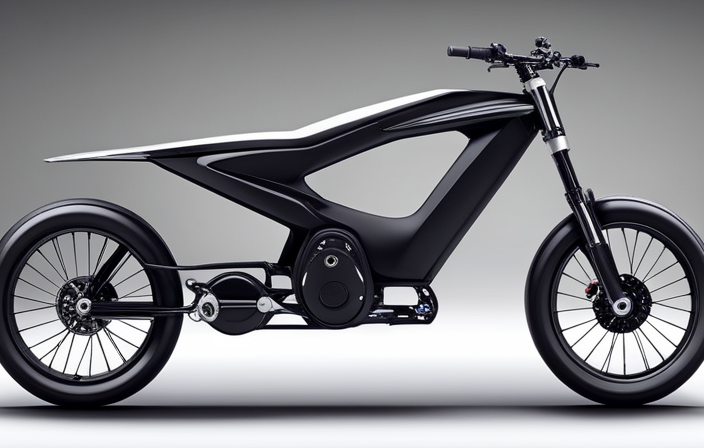As an avid electric bike rider, I’ve always marveled at the convenience and efficiency that these eco-friendly vehicles offer.
However, one burning question continually crosses my mind: How long do electric bike batteries really last?
In this article, we’ll delve into the world of electric bike batteries, exploring the different types, factors that affect their lifespan, and practical tips to extend their longevity.
So, if you’re curious to know whether your electric bike’s battery will stand the test of time, read on for all the answers you need.
Key Takeaways
- The lifespan of electric bike batteries depends on factors such as battery technology, usage, and maintenance.
- Li-ion batteries are the most advanced and commonly used type of electric bike batteries, offering higher energy density and longer lifespan.
- Constantly draining the battery to its lowest capacity and exposure to high temperatures can reduce the lifespan of electric bike batteries.
- When considering battery replacement, factors such as usage patterns, charging habits, temperature conditions, and overall battery care should be taken into account.
Types of Electric Bike Batteries
You’ll find that there are several types of electric bike batteries available on the market. When it comes to battery technology, there are three main types: lead-acid, nickel-metal hydride (NiMH), and lithium-ion (Li-ion).
Lead-acid batteries are the oldest type and provide a lower performance compared to the other two types. NiMH batteries offer a better performance and are more environmentally friendly, but they are heavier and have a shorter lifespan. On the other hand, Li-ion batteries are the most advanced and commonly used in electric bikes. They have a higher energy density, longer lifespan, and are lighter in weight.
When considering battery performance, it’s important to take into account factors such as voltage, capacity, and charging time. Transitioning into the next section about battery capacity, it’s worth noting that it plays a crucial role in determining the overall range and longevity of an electric bike battery.
Battery Capacity
If you ride regularly, your e-bike battery’s lifespan will depend on its capacity. Battery capacity refers to the amount of energy the battery can store, usually measured in watt-hours (Wh). The higher the capacity, the longer your battery will last.
A higher capacity battery will provide better performance and allow you to ride longer distances on a single charge. Battery technology plays a significant role in determining the capacity and overall lifespan of the battery. Advancements in battery technology have led to the development of higher capacity batteries that can last for several years with proper care and maintenance.
However, it’s important to note that battery performance can degrade over time, especially if not properly cared for or subjected to extreme temperatures. Understanding battery capacity and its impact on battery performance is crucial for maximizing the lifespan of your e-bike battery.
Moving on to battery usage and charging patterns…
Battery Usage and Charging Patterns
To ensure optimal performance and maximize the lifespan of your e-bike battery, it’s important to understand how your usage and charging patterns can impact its overall longevity. Here are a few key factors to consider:
-
Battery Usage: Constantly draining your battery to its lowest capacity can reduce its lifespan. It’s recommended to keep the battery level between 20% and 80% for regular rides.
-
Charging Patterns: Frequent short charges are better for the battery compared to infrequent full charges. Avoid leaving the battery connected to the charger for extended periods after it’s fully charged.
Battery overheating is another crucial aspect to consider. High temperatures can accelerate battery degradation. Therefore, it’s essential to store and charge your e-bike battery in a cool and well-ventilated area.
Understanding these usage and charging patterns, as well as the impact of temperature, will help you prolong the life of your e-bike battery.
Moving forward, let’s explore how environmental factors can also affect its overall lifespan.
Environmental Factors
Environmental factors such as temperature, humidity, and exposure to extreme weather conditions can significantly impact the lifespan of e-bike batteries. High temperatures, for example, can cause the battery to degrade faster and reduce its overall capacity. On the other hand, extremely cold temperatures can also affect the battery’s performance and reduce its range.
Humidity and exposure to moisture can lead to corrosion and damage the battery cells. It is important to note that these factors not only affect the battery’s lifespan but also its riding performance.
To maximize the battery’s lifespan, it is crucial to store and charge it in optimal conditions, away from extreme temperatures and moisture. Maintaining the battery’s health through proper care and regular check-ups is essential.
By ensuring these environmental factors are taken into consideration, you can prolong your e-bike battery’s lifespan and enjoy consistent riding performance.
Moving on to maintenance and care…
Maintenance and Care
When it comes to maintenance and care of electric bike batteries, there are a few key practices to keep in mind.
First, proper storage practices are essential for prolonging the lifespan of the battery. This includes storing the battery in a cool, dry place and avoiding extreme temperatures.
Second, regularly cleaning and inspecting the battery can help prevent any potential issues. This involves wiping the battery down with a damp cloth and checking for any signs of damage or wear.
By following these practices, you can ensure that your electric bike battery lasts as long as possible.
Proper Storage Practices
Proper storage practices can help prolong the lifespan of electric bike batteries. When it comes to proper storage, there are a few key considerations to keep in mind.
First, it is important to store the battery in a cool and dry place, away from direct sunlight or extreme temperatures. This helps prevent any damage caused by overheating or freezing.
Additionally, it is recommended to store the battery in a partially charged state, around 50% to 70% capacity. This helps prevent over-discharge or overcharge, which can negatively impact the battery’s overall lifespan.
Finally, there are various battery storage options available, such as dedicated battery bags or cases, which provide additional protection during storage.
By following these proper storage practices, you can ensure that your electric bike battery stays in optimal condition for longer.
Speaking of maintenance, the next crucial step is cleaning and inspecting the battery.
Cleaning and Inspecting the Battery
To ensure optimal performance, it’s important to regularly clean and inspect your e-bike battery. Here are three key steps to follow for proper battery maintenance:
-
Clean the battery: Start by disconnecting the battery from the e-bike. Use a soft cloth or sponge with mild soap and water to gently wipe down the exterior of the battery, removing any dirt or grime. Avoid using abrasive cleaners or solvents that may damage the battery casing.
-
Inspect for damage: Carefully examine the battery for any signs of physical damage, such as cracks or dents. Check the battery terminals for corrosion, ensuring they are clean and securely attached. Look for any loose wires or connections that may need to be tightened.
-
Check battery performance: Use a voltmeter or battery tester to measure the voltage of the battery. Compare the reading with the manufacturer’s specifications to ensure it is within the recommended range. If the voltage is significantly lower, it may indicate a need for replacement.
Regular battery cleaning and inspection can help prolong the life of your e-bike battery.
Speaking of battery life, let’s now discuss how age and cycle life affect the longevity of electric bike batteries.
Age and Cycle Life
The average lifespan of electric bike batteries can vary depending on several factors. These factors include the quality of the battery, how it is used and maintained, and the specific type of battery technology.
It is important to understand these factors as they can greatly influence the cycle life of an electric bike battery.
Average Lifespan of Electric Bike Batteries
On average, electric bike batteries last for several years before needing to be replaced. The lifespan of electric bike batteries can vary depending on several factors, such as the quality of the battery, how it is used and maintained, and the specific brand and model.
Most electric bike batteries have a warranty coverage that typically ranges from 1 to 3 years, ensuring that if any issues arise within that time frame, the battery can be replaced or repaired by the manufacturer. After the warranty period, if the battery starts to degrade or lose capacity, it may be time to consider battery recycling options. Proper disposal and recycling of electric bike batteries are important to minimize environmental impact.
Factors influencing the cycle life of electric bike batteries include usage patterns, charging habits, temperature conditions, and overall battery care.
Factors Influencing Cycle Life
Factors that can affect how long your electric bike battery will continue to perform optimally include usage patterns, charging habits, temperature conditions, and overall battery care. By understanding these battery lifespan factors and implementing certain practices, you can extend the life of your electric bike battery.
One key factor is usage patterns. Regularly subjecting your battery to high loads and deep discharges can decrease its overall lifespan. It’s important to maintain a balance between power consumption and battery capacity.
Charging habits also play a role. Avoid overcharging or letting the battery drain completely before recharging. This can cause stress on the battery and shorten its lifespan.
Temperature conditions are another crucial factor. Extreme heat or cold can impact battery performance and reduce its longevity. It’s best to store and operate your electric bike in temperature-controlled environments.
Lastly, proper battery care is essential. This includes regular cleaning, avoiding physical damage, and keeping the battery away from moisture and direct sunlight.
Understanding these factors and implementing good practices can help extend the life of your electric bike battery. In the next section, we will discuss the importance of manufacturer and battery quality in ensuring optimal battery performance.
Manufacturer and Battery Quality
One thing to consider is the lifespan of electric bike batteries. When it comes to the longevity of these batteries, two crucial factors are the manufacturer reputation and the battery warranty.
A reputable manufacturer is more likely to produce high-quality batteries that are built to last. Additionally, a longer battery warranty gives you peace of mind that the manufacturer stands behind their product’s durability. It’s important to research and choose a trusted brand that has a good track record in the industry.
However, it’s also worth noting that the lifespan of electric bike batteries can be influenced by other factors, such as riding conditions and terrain. These aspects will be discussed in the subsequent section, shedding light on how they affect the overall battery life.
Riding Conditions and Terrain
Riding conditions and terrain can significantly impact the lifespan of e-bike batteries. Faster speeds tend to consume more battery power, so if you frequently ride at high speeds, your battery may not last as long. On the other hand, riding at a more moderate pace can help prolong its lifespan.
The type of terrain you ride on can also affect battery performance. Hilly or rough terrain requires more power from the motor, which drains the battery faster. In contrast, riding on flat or smooth surfaces puts less strain on the battery.
Understanding how riding conditions and terrain affect battery performance is essential for maximizing the longevity of your e-bike battery.
Transitioning into the next section, let’s now discuss battery capacity degradation.
Battery Capacity Degradation
Battery capacity degradation can be influenced by various factors, such as the frequency of charging and discharging. To ensure optimal battery capacity preservation and prolong the life of your electric bike battery, it is important to understand how these factors can impact its longevity. Here is a table summarizing some key factors that can affect battery capacity degradation:
| Factors | Impact |
|---|---|
| Frequency of charging | Frequent charging can lead to faster battery degradation. It is recommended to charge your battery only when necessary. |
| Depth of discharge | Deeper discharge cycles can accelerate capacity loss. Try to avoid fully depleting the battery and aim for partial discharge cycles instead. |
| Temperature | Extreme temperatures, both hot and cold, can negatively affect battery performance and durability. Store and charge your battery in a cool, dry environment for optimal results. |
| Proper maintenance | Regularly inspecting and cleaning your battery, as well as following manufacturer guidelines, can help prolong its lifespan. |
| Quality of charger | Using a charger specifically designed for your electric bike battery and avoiding cheap or incompatible chargers is crucial for battery health. |
By understanding and implementing these battery preservation techniques, you can extend the life of your electric bike battery. In the following section, we will discuss battery upgrades and replacement options, which can further enhance your riding experience.
Battery Upgrades and Replacement
If your electric bike battery needs to be upgraded or replaced, there are options available to enhance your riding experience.
Upgrading your battery can provide you with several benefits. Firstly, you can increase your bike’s range, allowing you to go on longer rides without worrying about running out of power. Additionally, a higher capacity battery can give you more power and torque, allowing you to tackle hills and rough terrain with ease. Furthermore, upgrading to a newer battery model can improve the overall performance and efficiency of your electric bike.
If upgrading is not an option for you, there are also battery replacement options available. Many manufacturers offer replacement batteries that are compatible with their electric bike models. These options allow you to continue enjoying the benefits of electric biking without having to invest in a completely new bike.
Now, let’s delve into some battery maintenance tips to ensure your electric bike battery lasts as long as possible.
Battery Maintenance Tips
To ensure optimal performance and longevity, it’s important to regularly maintain and care for your e-bike battery. Here are some battery maintenance tips that can help extend the lifespan of your battery:
- Store your battery in a cool and dry place to prevent damage from extreme temperatures.
- Avoid storing your battery at full charge or completely depleted, as both can lead to reduced capacity over time.
- Clean the battery contacts regularly with a soft cloth to prevent corrosion and ensure a good connection.
- Inspect the battery for any signs of damage or wear, such as cracks or bulges, and replace if necessary.
- If you won’t be using your e-bike for an extended period, consider removing the battery and storing it separately.
By following these battery maintenance tips, you can prolong the life of your e-bike battery and prevent issues such as battery corrosion.
Now, let’s move on to the next section about charging practices.
Charging Practices
When it comes to charging electric bike batteries, there are a few key points to keep in mind.
First, it’s important to use optimal charging methods to ensure the longevity of the battery. This means using the correct charger and avoiding overcharging or undercharging.
Second, charging frequency also plays a role in battery lifespan. It’s recommended to charge the battery after each use to maintain optimal performance.
Finally, the duration of each charging session should be considered. It’s best to charge the battery until it reaches full capacity and then disconnect it from the charger.
By following these practices, you can maximize the lifespan of your electric bike battery.
Optimal Charging Methods
For optimal charging methods, you’ll want to follow the manufacturer’s recommendations. Battery charging techniques can vary depending on the specific electric bike model, so it’s important to consult the user manual for the best practices.
One of the key battery longevity tips is to avoid overcharging. Most electric bike batteries have a built-in protection system that prevents overcharging, but it’s still wise to unplug the charger once the battery reaches full capacity.
Additionally, it’s recommended to charge the battery at room temperature and avoid exposing it to extreme heat or cold. This will help maintain the battery’s performance and extend its overall lifespan.
When it comes to charging frequency and duration, finding the right balance is essential. I’ll discuss this further in the next section.
Charging Frequency and Duration
Finding the right balance in how often and for how long you charge your electric bike battery is essential.
Your battery charging habits can have a significant impact on the overall longevity of your battery. It is recommended to charge your electric bike battery after each ride, especially if you have used a significant amount of power. However, avoid overcharging your battery, as this can lead to decreased battery life.
It’s best to charge your battery until it reaches around 80% to 90% capacity, as this helps to prolong its lifespan. Additionally, avoid leaving your battery fully discharged for extended periods, as this can also negatively affect its longevity.
By following these charging guidelines, you can ensure that your electric bike battery lasts for a long time.
Now, let’s move on to discussing battery management systems.
Battery Management Systems
To maximize the lifespan of your electric bike battery, you should regularly monitor its performance using a battery management system. This system allows you to optimize battery performance and monitor battery health, ensuring that you get the most out of your battery. By using a battery management system, you can keep track of important metrics such as voltage, temperature, and charging cycles. This information is crucial in maintaining the longevity of your battery and preventing any potential issues.
Using a battery management system evokes a sense of control and peace of mind. It allows you to stay on top of your battery’s health, ensuring that it remains in optimal condition for as long as possible. With this system, you can proactively address any concerns and take necessary measures to extend the lifespan of your battery.
Moving forward to the next section about extending battery lifespan, it is important to understand the impact of charging habits on battery longevity.
Extending Battery Lifespan
Now that we have explored the importance of Battery Management Systems in maintaining the health of electric bike batteries, let’s delve into some strategies for extending their lifespan.
Maximizing battery life is crucial for optimal battery performance and getting the most out of your electric bike. One key way to achieve this is by avoiding extreme temperatures, as both excessive heat and cold can negatively impact battery performance.
Additionally, regular charging and discharging cycles can help prevent battery degradation. It’s also important to store the battery properly during periods of non-use, ensuring it is kept in a cool and dry place.
By following these guidelines and taking proper care of your electric bike battery, you can greatly extend its lifespan and enjoy longer rides.
Now, let’s move on to the next section where we will discuss cost considerations when it comes to electric bike batteries.
Cost Considerations
When considering the cost of an electric bike, it’s important to take into account the potential costs of battery replacement.
Electric bike batteries typically last between 2-5 years, depending on usage and maintenance.
The cost of replacing a battery can range anywhere from $500 to $1000, making it a significant expense to factor in when evaluating the overall cost of owning an electric bike.
However, it’s also important to consider the lifespan of the battery and the potential savings in fuel costs over time, as these factors can help offset the initial investment.
Battery Replacement Costs
The cost of replacing electric bike batteries can vary. When it comes to battery replacement costs, there are a few factors to consider.
Here are three important things to know:
-
Battery disposal methods: It’s crucial to dispose of old batteries properly to avoid harm to the environment. Many electric bike manufacturers offer battery recycling programs, making it easier for riders to safely dispose of their old batteries.
-
Battery recycling programs: These programs allow you to return your old battery to the manufacturer or a designated recycling center. They ensure that the battery components are recycled or disposed of in an environmentally friendly manner.
-
Cost vs. lifespan analysis: When evaluating battery replacement costs, it’s essential to consider the lifespan of the battery. While some batteries may seem expensive upfront, they may have a longer lifespan, making them more cost-effective in the long run.
Considering these factors can help you make an informed decision about battery replacement.
Now, let’s delve into the cost vs. lifespan analysis.
Cost vs. Lifespan Analysis
One important factor to consider is the cost vs. lifespan analysis when evaluating the replacement of electric bike batteries. It is essential to understand how the cost of a battery relates to its lifespan and performance. A battery’s lifespan is determined by various factors, including usage patterns, charging habits, and battery chemistry. Generally, higher-quality batteries tend to have a longer lifespan and better performance. However, they may also come with a higher price tag. To help visualize this, consider the following table:
| Battery Type | Lifespan | Cost |
|---|---|---|
| Standard | 2-3 years | $200 |
| High-Quality | 4-6 years | $400 |
| Premium | 6-8 years | $600 |
As shown in the table, investing in a high-quality or premium battery may initially cost more, but it can provide a longer lifespan and better battery efficiency. Ultimately, the decision should be based on your specific needs and budget.
Frequently Asked Questions
Can I use any type of electric bike battery with my electric bike?
No, you cannot use any type of electric bike battery with your electric bike. Battery compatibility is important to ensure optimal performance and safety. Using a specific electric bike battery designed for your bike will provide advantages such as better efficiency and longer lifespan.
How does temperature affect the lifespan of electric bike batteries?
Temperature plays a crucial role in the lifespan of electric bike batteries. Extreme heat or cold can degrade the battery, reducing its overall capacity and performance. It is important to avoid exposing the battery to extreme temperatures during charging and storage.
Is it possible to upgrade the battery on my electric bike to increase its range?
Yes, it is possible to upgrade the battery on an electric bike to increase its range. Upgrading the battery capacity can provide a longer distance per charge. However, it may be expensive and could affect the bike’s weight and performance.
Are there any specific maintenance tips to ensure the longevity of my electric bike battery?
To ensure optimal battery longevity, it’s essential to follow specific maintenance tips. Regularly clean and inspect the battery, avoid extreme temperatures, and charge it according to the manufacturer’s guidelines. By doing so, you can maximize your electric bike battery’s lifespan.
What are the factors to consider when determining the cost of replacing an electric bike battery?
When determining the cost of replacing an electric bike battery, factors such as the brand, capacity, and quality of the battery must be considered. On average, electric bike batteries last around 3-5 years before needing replacement.
Conclusion
In conclusion, the lifespan of electric bike batteries depends on various factors. These factors include the type of battery, usage patterns, environmental conditions, and maintenance practices. By understanding these factors and implementing proper care and charging practices, it is possible to extend the battery’s lifespan significantly.
However, it’s important to consider the cost implications of battery replacement when purchasing an electric bike. As the saying goes, ‘A stitch in time saves nine.’ Investing in proper battery care and maintenance can save you from costly replacements in the long run.
